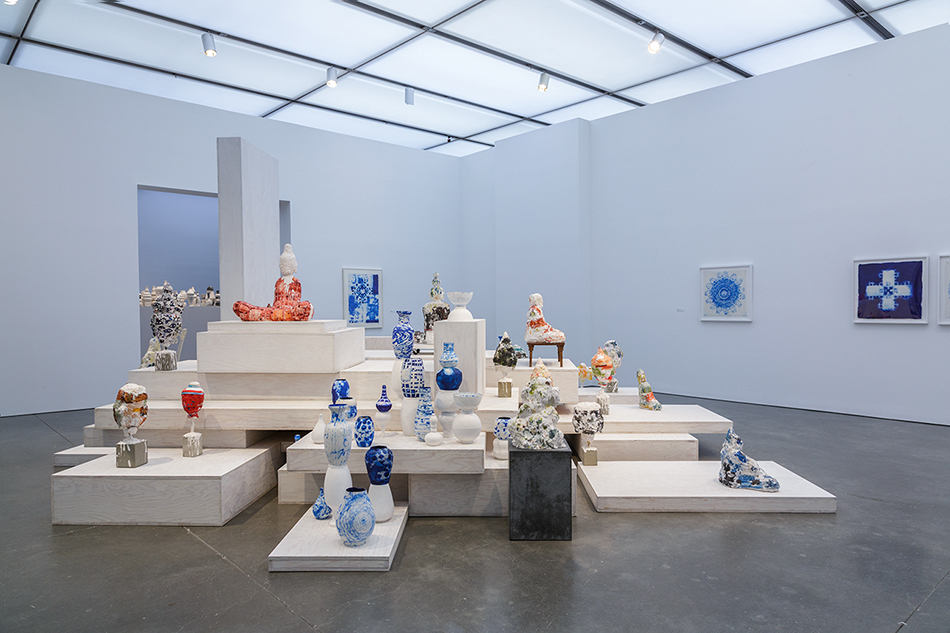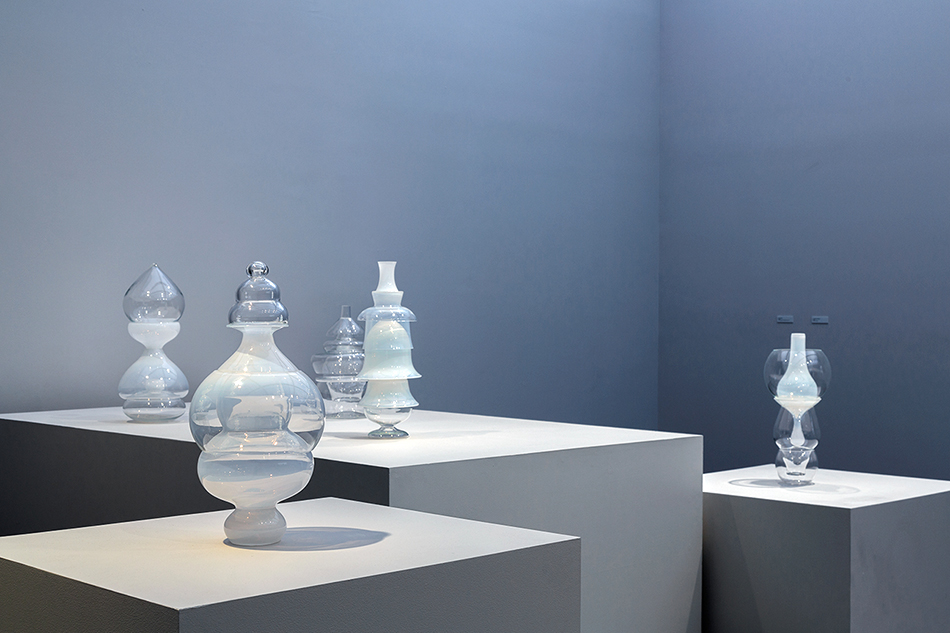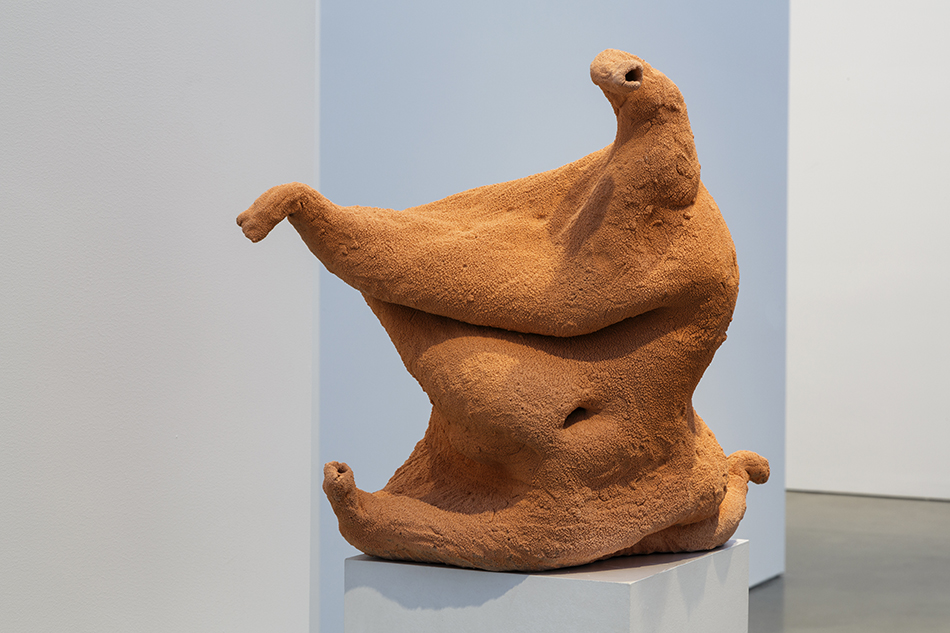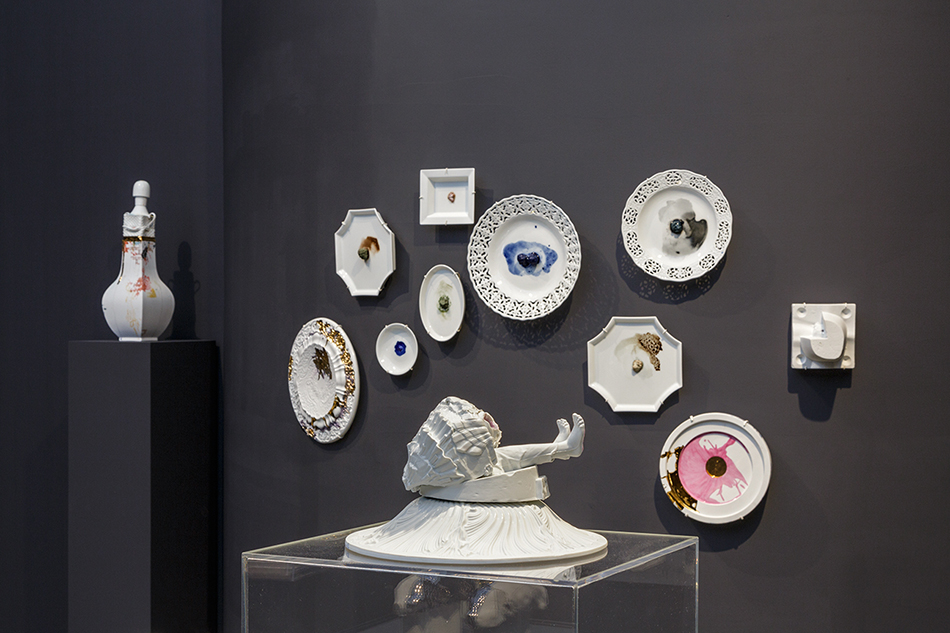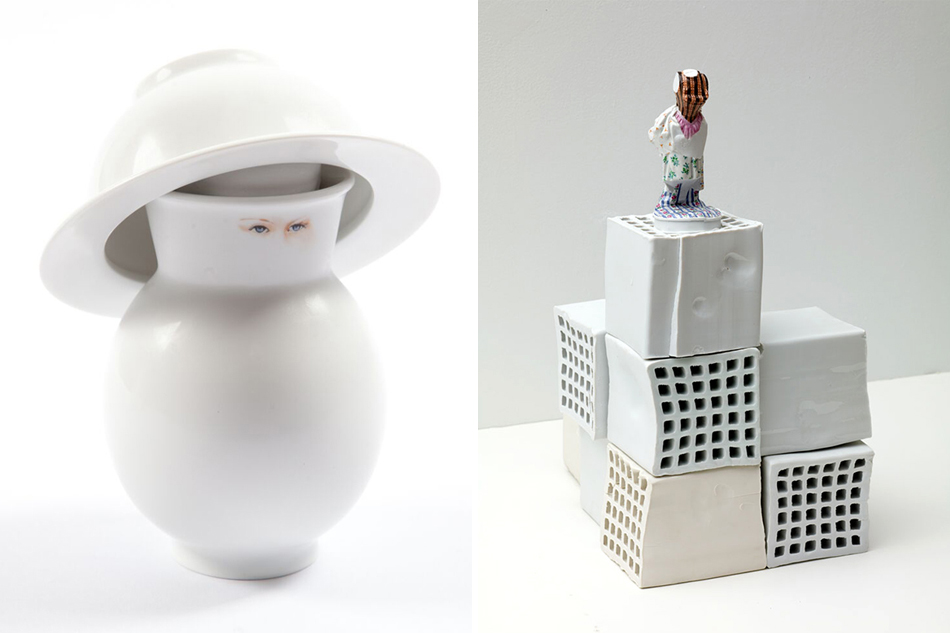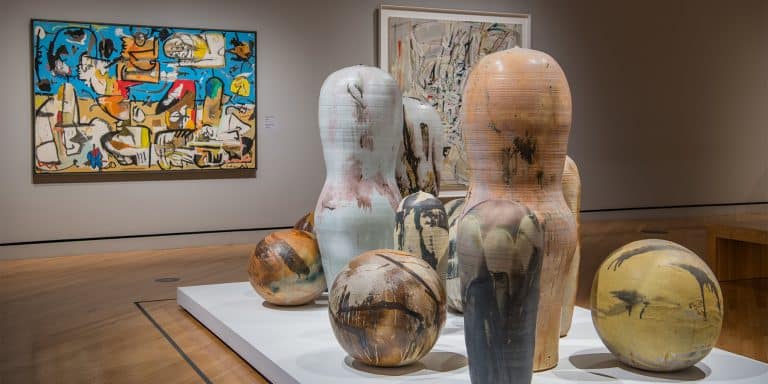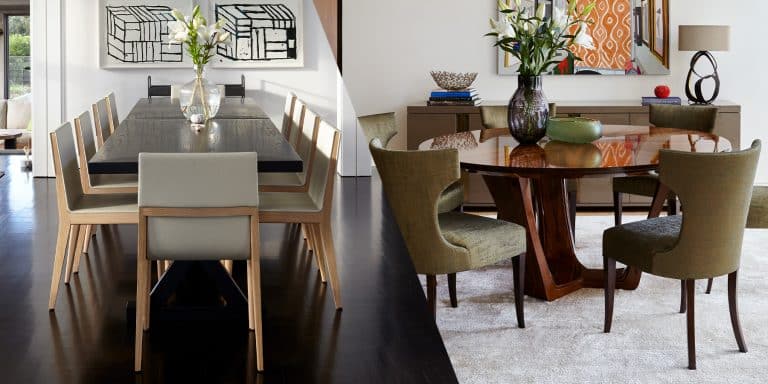
July 6, 2015“The essence of the material is that the skin can become part of the form,” says Arlene Shechet, who prefers to make her own glazes for her ceramic works. Top: On view at the Institute of Contemporary Art in Boston, the artist’s first museum survey features 150 pieces exhibited on her signature quirky pedestals, which incorporate materials from vintage furniture to chunks of wood. Photo by John Kennard, all photos courtesy of the Institute of Contemporary Art, Boston
Arlene Shechet is dressed in a long, black, button-front smock and cropped yoga pants as she circles a gray ceramic sculpture in her Tribeca basement studio. It is a curious shape, with a center that swells as it rises, cantilevering precariously to one side. Inside that billowing form is nothing more than air. “Within that solid thing I’m trying to convey puffiness and lightness and air and time,” says the New York–born artist, “like something ecstatic and something sad at the same time.”
It was, in fact, the “air-as-armature” concept that helped lead her to ceramics in the first place, some nine years ago. And, although she has worked in a vast range of mediums over the course of her decades-long career, clay has emerged as the material with which she is, arguably, most closely associated. Shechet’s mysteriously beautiful clay pieces — as well as her plaster Buddhas, delicately balanced crystal works, whimsical porcelains and blue-and-white mandalas on paper — are now the subject of her first-ever museum survey: “Arlene Shechet: All at Once,” on view at the Institute of Contemporary Art in Boston through September 7. Featuring 150 works produced over the course of 20 years, the show offers a comprehensive study of Shechet’s beguiling oeuvre.
It was a confluence of events, both personal and professional, that drew Shechet, who is now represented by Chelsea’s Sikkema Jenkins & Co. gallery, to take up ceramics. She was tiring of the constant collaboration involved with her crystal pieces, which required that glass artisans blow her designs (a highly specialized craft) before she could cut them and assemble the parts, like a puzzle, into their graceful but voluptuous final forms. Her mother had recently died, and she was caring for her father, who was suffering from congestive heart failure — making the issue of breath a constant concern. On her return from a trip to India, Shechet dreamed about fire. “I interpreted that as being about these oil lamps that I had seen in India,” she recalls. Then Betty Woodman, the much-admired ceramicist, called. Woodman’s late daughter, Francesca, a photographer, had been a close friend of Shechet’s during grad school at the Rhode Island School of Design, and Woodman, who was headed to Italy, was trying to rustle up some work for her assistant while she was away.

Shechet’s first body of ceramic sculptures — which includes Air Time, 2007 — was inspired by the idea of breath. As such, it resembles smoke puffs, clouds, lungs, oil lamps and other air-filled forms, all grounded by heavy monochromatic and metallic glazes. Photo by Alan Wiener
Shechet thought clay might serve as a good antidote to the fragile, transparent crystal, so she hired the assistant. “The glass is so pure and beautiful,” she says. “I was looking for the opposite of that. I wanted the mud thing happening.” Initially, she says she saw ceramics as a fun hobby and found the medium’s technical characteristics and quirks — particularly the need to make pieces hollow — “weird.” But soon those very constraints began to fascinate her.
“I realized it’s all about hollow,” she says, explaining that the air filling the ceramics’ cavities brought to mind her father’s struggle to inhale, as well as the glass artisans’ careful control of their own breath. “Clay is very mushy material — it has no structure, but it has to be built hollow,” she says. “That means air is acting as structure, which is an interesting conceptual idea for me. So you’re containing air, and air is actually helping the thing survive, at the same time that it’s making it more difficult to build. So air and time are the essential things. It becomes its own armature, so you don’t have to predetermine what you’re going to make.” She began to make lamp-like sculptures that referenced the oil lamps of her dream, and she bought a small kiln on eBay. Soon she was experimenting with all manner of abstract form.
Ceramics has become something of a trendy field in art in the last few years — Sterling Ruby’s oversize pinch pots, for instance, were a big hit at the 2015 Whitney Biennial — but that was not the case when Shechet first got her hands dirty. “The other reason I was attracted to clay was that it was such a devalued material,” she says. “Ceramics was in the dumps.” Shechet purposely kept the interiors of her hollowed coils unglazed to announce, “ ‘Make no mistake, this is brown clay here.’ I liked the idea that it was so marginalized, that there was a lot of potential and freedom unexplored,” she says.
“Within a solid thing I’m trying to convey puffiness and lightness and air and time, like something ecstatic and something sad at the same time.”

As with the multihued abstract 2011 form Is and Is Not — which recalls an underwater sea monster — Shechet puts her ceramics through a number of perils, primary among them multiple rounds of glazing and firing, which increases the risk of breakage in the 2,000-degree kiln. Photo by Alan Wiener
Explore she has. Her works tilt and bulge and sometimes appear on the point of collapse. One might resemble a beehive, another an underwater creature with a giant, squashed mouth. Some have odd appendages; others are affixed with kiln firebricks. “Over a period of time, I see tons of stuff in them,” she says. “I’ve had my experience” — and she wants viewers to have their own. “I’ve always wanted to make something that is more than an idea. I don’t want it to be spoken about easily. When the thing reaches that liminal, hybrid, unknowable state, that’s when I’m happy, and that’s when I let it out of my studio. If it can be pinned down too easily, I’m not interested in it and I have to get rid of it.”
Making ceramics is a constant gamble, and Shechet is a high roller. If she tries to add something when the clay is too wet, it will collapse; if it’s too dry, it won’t stick. She typically models a piece for six months to a year. Then comes the real danger: firing it in a 2000-degree kiln, which puts the sculpture at risk of breaking. Next come multiple rounds of glazing and firing, each time notching up the threat of damage in the kiln. “There’s no guarantee,” she says. “It’s completely not going to be controlled. Sometimes it’s terrible, and then I throw it out.”
Shechet could opt to paint the pieces instead of glazing them, and thereby eliminate the repeated peril of firing, but in her view, glaze is intrinsic to the beauty of ceramics. “The essence of the material is that the skin can become part of the form,” she says. “Color and form are fused together.” She formulates most of her glazes herself, and they possess not just a brilliant spectrum of colors but an incredibly diverse range of textures, from glossy to smooth and chalk-like to bumpy, evoking sand or beads.

Proof, 2013, which Shechet made by applying brightly colored pigment to cotton grounds cast around materials she uses in her studio — kiln bricks, tabletop leftovers or chunks of clay — is part of her ongoing exploration of color and weight. Photo by Alan Wiener
A Queens native, Shechet grew up going to museums with her mom, who was a hobbyist painter. She earned her BA from NYU and then, after a few years of odd jobs, went to RISD for her MFA. Asked if she was always a sculptor, she replies, “It’s how you’re born.” She pauses, then adds, “I actually did a lot of painting, but I always felt that I was cheating. I also did a lot of photography and had that same feeling: I’m just not dug in deep enough.” Sculpting, she says, offers the “resistance” she needs. Still, glazing makes her feel like a painter again, and she covered her plaster Buddhas with what she calls “paint skins” — layers of paint applied to glass or plastic and then peeled away.
Shechet taught sculpture at RISD for five years, and then for another 10 years at Parsons School of Design in New York, a period during which she occasionally showed her work but never had real gallery representation. Although she is of a generation of female artists who largely sacrificed having children — some out of fear that babies would interfere with art-making, while others worried they would no longer be taken seriously as artists — she was also raising a family at the time. She bonded during these years with artist Laurie Simmons, whose two daughters are roughly the ages of Shechet’s 20-something daughter and son, finding common ground in their pregnancies and the experience of being both mother and artist.
“I had to hide having children,” she says. Indeed, when she was eight months pregnant, before hosting a studio visit with a representative from a corporate collection, “I remember spending an hour thinking about what to wear to conceal that I was pregnant,” she says. “It was definitely a sad thing that you could be written off.”
While teaching, though, she flaunted her pregnancy to both male and female students. “It was a political act to be standing in front of a class as a woman and pregnant and functioning,” she says, adding that she took only one day of maternity leave. And while she calls teaching an “enormous gift,” she says there came a time when she finally felt like she was “hiding out,” and she dreaded the possibility that she’d regret not having devoted more time to her own practice. “Between teaching, having kids and being in my studio,” she says, “I had absolutely zero time for any kind of studio visit.”

In Tattletale, 2012, Shechet integrates actual kiln bricks and shelf with glazed ceramic into the piece. Photo by Martin Brading
Once, she remembers, after carefully juggling and organizing all of her various other obligations, she was finally able to arrange a studio visit with an important curator, only to have him cancel at the last minute. “I burst out crying,” she says. But when she finally found the courage to quit teaching, her career started to take off.
Today, Shechet continues to test the boundaries of her current medium of choice, and is, as ever, a champion of experimentation. Still, there are through lines in her oeuvre, including a rejection of traditional sculptural armature, which she feels “takes away my opportunities to work in the immediate present and to make decisions as I see it rather than as I know it.” Her considered installations make use of quirky pedestals like vintage furniture, kiln bricks or chunks of wood, because she loathes the idea of generic cubes. There’s also her continued tendency to draw attention to process, highlighting the inner workings of the studio or factory. And there’s her relationship to time, which finds her constantly racing against the clock. “I’ve always used time as a kind of material,” she says, adding that her Buddhas were a “specific, performative kind of work” for which the challenge was to make one a day, completing each before the plaster dried.
Ultimately, Shechet is an adventurer. She says she adheres to the late Expressionist painter Philip Guston’s belief about the dangers of complacency — which contends that every five years or so, an artist probably knows too much and needs to make a shift — even while acknowledging that this philosophy may impinge on her earnings. “In my career, which is separate from my art life, to a certain extent I’ve been hurt by switching,” she says. “People want to label you; product identity is what people feel comfortable with. But when clay stops being an unknown, I will probably stop doing it.”
VISIT SIKKEMA JENKINS & CO. ON 1STDIBS

